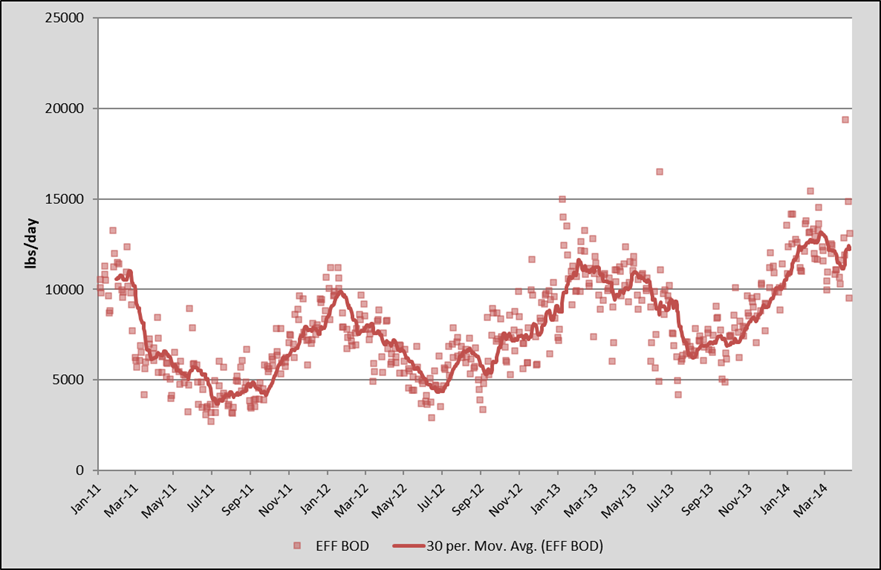Onsite Support & Services
Aerated Stabilization Basins (ASB) | Lagoon Support
Wastewater System Evaluation
Historical Data Review
The review involves an assessment of loading and performance data from the past 3 – 5 years. Results may indicate potential areas of system deterioration and/or areas for improvement. Incorporating a historical data review in a comprehensive system evaluation allows one to assess performance trends and identify areas of focus prior to beginning onsite work. Areas of focus include aeration horsepower utilization, nutrient control, BOD loading and removal, and TSS loading and removal.

Figure 1: BOD loading and removal

Figure 2: Seasonal swings and performance loss over time
Depth Survey
EBS uses equipment manufactured for shallow water surveying coupled with industry-leading data acquisition software to provide accurate and detailed system surveys. The data obtained from a depth survey will provide the current water volume and the average depth of the system. Additionally, the survey data will provide the theoretical retention time (TRT) or volume that is available for treatment. Conducting surveys on a routine basis can give a detailed look at solids accumulation over time and be used to compare depth/volume before and after capital projects such as dredging or aerator reconfiguration.
Depth surveys can be conducted using a manned boat or a remotely operated unmanned survey vessel (USV). With the USV, surveys can be conducted on basins not traditionally considered accessible. The size of the USV enables it to easily be placed into elevated or lowered structures. Use of the USV is ideal if personnel safety on the basin is a concern.

Image 1: Unmanned Survey Vessel (USV)

Image 2: Traditional manned boat

Figure 3: Bathymetry map with cross sections

Figure 4: Bathymetry map monitoring impact of dredging
Drone Survey
We have expanded our on-site support capabilities to capture valuable data from the sky. The Matrice 300 commercial drone sets a whole new standard by combining intelligence with high-performance and unrivaled reliability. It offers up to 55 minutes of flight time, advanced AI capabilities, 6 directional sensing and positioning sensors, IP45 weather protection and more. The Matrice 300 can reach altitudes of ~16,000 feet, can operate in temperatures ranging from -4°F to 104°F, and has a transmission range of up to 9 miles.
Capabilities:
- A 20-megapixel camera captures high-resolution aerial photos and videos of your entire treatment system.
- 640×512 thermal imaging identifies potential flow breakthroughs.
- Advanced water sampling technology enables EBS and/or facility employees to safely and efficiently collect samples from potentially hazardous environments.
Performance Profile
Performance profiles provide a snapshot of the system’s health during the sampling period. Typical field measurements can include temperature, pH, dissolved oxygen (DO), and oxidation-reduction potential (ORP). Samples are collected and analyzed for dissolved oxygen uptake rate (DOUR), nutrient concentrations (ammonia and orthophosphate), chemical oxygen demand (COD), biochemical oxygen demand (BOD5), total suspended solids (TSS), and volatile suspended solids (VSS).

Figure 5: Profile Study: DO, DOUR, ORP
Tracer Study
While a depth survey can provide the information needed for the theoretical retention time, the most accurate way to assess the hydraulic retention time of the system is by conducting a tracer study. The study involves the introduction of tracer material. After the introduction, samples are taken in-basin, to determine flow patterns, and at the effluent to determine actual retention time.
Laboratory Assessments
Laboratory results can have an impact on compliance with state regulations and permits, so it is important to assure that on-site laboratory operations keep current with Standard Methods and best practices. Industrial labs occasionally desire an audit that reviews current lab testing processes, laboratory-generated data, written procedures, and QC data. The objective is to identify areas for continuous improvement and confirm that accurate results are being obtained by the laboratory. EBS has performed many industrial wastewater treatment lab assessments to provide clients with this important information as well as training for those performing the tests. The outcome of an EBS lab audit is a written laboratory audit report containing observations and recommendations for improvement to ensure companies maintain optimum high-quality test results for their plant permits and the operational decision-making process
